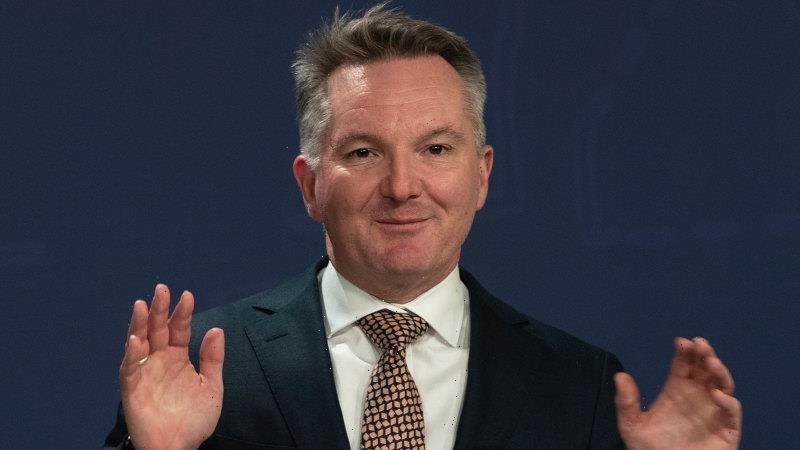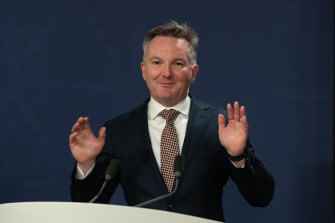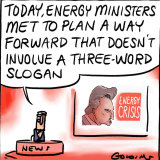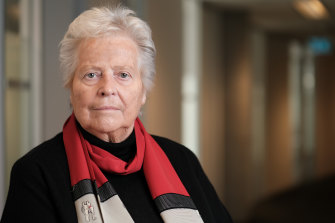Large power companies and energy experts insist new rules to drive funds into gas-fired power stations will be vital to backing up renewables and smoothing the energy transition, but some state and federal ministers are at loggerheads over the future of the fossil fuel.
In an emergency meeting on Wednesday to discuss soaring power and gas prices, Australia’s energy ministers agreed to push ahead with sweeping reforms to bolster the electricity grid and ensure an orderly shift away from fossil fuels. The proposals included introducing a so-called “capacity market”, which would reward energy projects for guaranteeing power that can be called upon when needed, rather than only paying them for the power they produce.
Federal Energy Minister Chris Bowen says his state counterparts are working on climate change reforms in a “spirit of cooperation”.Credit:Janie Barrett
The reforms are spearheaded by federal Energy Minister Chris Bowen and mainly aimed at spurring investment in technologies such as big batteries and pumped hydro. However, it is expected to be “technology-neutral” and has sparked concerns among green groups and the Victorian government that it may lead to prolonging the life of coal and gas in the energy market.
All states and territories have already committed to reduce emissions and decrease the use of coal in their power grids to hit net zero by 2050.
Victorian Energy Minister Lily D’Ambrosio said the state was not supportive of a policy that could entrench fossil fuel generation.
Credit:Matt Golding
“We have always been clear that a capacity market operating in Victoria would make payments to zero-emissions technologies and not fossil fuels,” D’Ambrosio said on Thursday. “What other states choose to do in terms of how the capacity market could operate in other states is a matter for them.”
NSW Treasurer and Energy Minister Matt Kean said his preferred model for the capacity mechanism is the NSW Electricity Infrastructure Roadmap. It bars coal, but could include gas.
“[The roadmap] tenders for new renewable storage, generation and firming,” Kean said.
The ACT has previously rejected the need for fossil fuels to back up renewables.
Bowen this week described the capacity mechanism as a “matter of urgency” and said the energy ministers would consider a range of options that had been developed by the Energy Security Board (ESB).
The ESB has said states could have different operating principles in their jurisdictions, such as excluding fossil fuels.
Alinta, one of the nation’s largest electricity suppliers and owner of the Latrobe Valley Loy Yang B brown coal-fired power plant, said the tight energy market conditions meant “every technology and fuel is playing an important role in keeping the lights on”.
“So, yes, we do need coal and gas to be included in a capacity market,” Alinta chief executive Jeff Dimery said. “If you were to exclude the roughly 60 per cent of supply provided by the Latrobe Valley in Victoria, there wouldn’t be much capacity left to call on.”
Dimery said Alinta was not advocating for coal to remain in the mix for a “minute longer than necessary … and we’re getting on with developing the next generation of energy like offshore wind and hydro”.
“But they have a critical role to perform in the short to medium term,” he said.
Origin Energy chief executive Frank Calabria welcomed the “thoughtful and collaborative” effort between state, territory and federal government to address the challenges facing the energy market, and said the proposed capacity mechanism should include storage, pumped hydro and gas peakers.
Tony Wood, energy director at the Grattan Institute think tank, said short-burst gas peaking plants would be critical stop blackouts by backing up long-duration wind and solar farms that don’t work when the wind doesn’t blow or the sun doesn’t shine.
But no matter what rules were put in place to run the capacity market, he added, coal would not be economically viable.
“I don’t know how you back up renewables with other renewables,” Wood said, noting that batteries recharged by wind and solar still needed to be supplemented with other power generation.
“Even the UK has some of its capacity mechanism that encourages a diesel reserve [for electricity generation].”
Wood said coal generators would be too costly to run and too slow to fire up at short notice, to fill gaps in the grid when the weather changes.
“You need capacity that can come on very quickly and the problem for coal plants is they’re not very flexible.”
Kerry Schott, former chair of the ESB and architect of the capacity mechanism design proposals brought to the energy ministers, said every country developing a renewable electricity grid has a capacity market and “it’s one of my great regrets that it has taken so long” to be brought into Australia.
Schott told the Australian Energy Week conference on Thursday that while she hadn’t seen the finalised proposal to be put to ministers, she thought it could exclude funds for coal but rule in gas.
Kerry Schott says one of her “great regrets” is that it has taken so long for a capacity market to be brought into Australia.Credit:Oscar Colman
There are expected to be two models that ministers could choose between.
Under one, the Australian Energy Market Operator (AEMO) would determine how much dispatchable power was needed to back up renewables across the electricity grid and it would contract to buy this capacity from a range of generators. Electricity retailers would be required to bid to buy this capacity in an auction, which would be used to fund the necessary power generation projects.
The other model is a market-based mechanism that cuts out AEMO as the middle man, where retailers have to purchase enough dispatchable capacity to back up the electricity generation they are buying from power generators.
Schott cautioned that the market mechanism was more complicated, while it was likely that AEMO would be too risk-averse under the capacity reserve and spend more money than necessary buying backup power.“Neither is ideal, but we do need something,” she said.
EnergyAustralia managing director Mark Collette said the orderly transition from coal was the “big challenge of the energy system”, and he was encouraged that ministers were prioritising the ESB’s proposals.
“Providing the right investment signals for new capacity is essential for our energy transition,” he said. “Equally essential is an orderly retirement of coal generation – timed so that the new system is ready beforehand. ”
Cut through the noise of federal politics with news, views and expert analysis from Jacqueline Maley. Subscribers can sign up to our weekly Inside Politics newsletter here.
Most Viewed in Politics
From our partners
Source: Read Full Article



